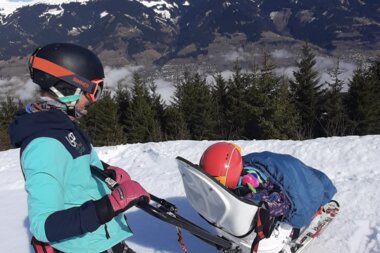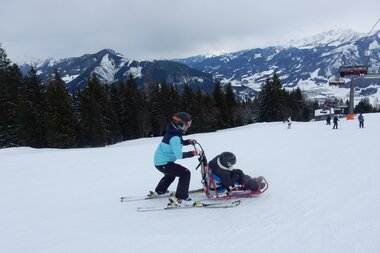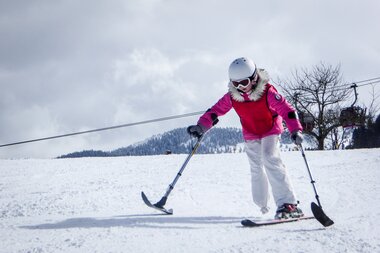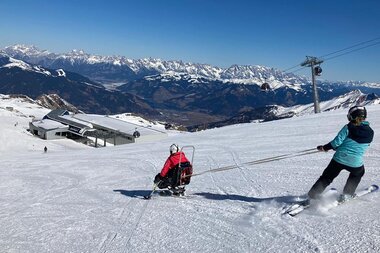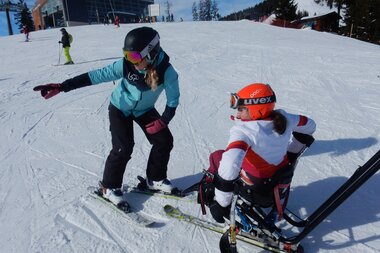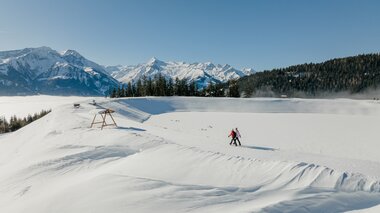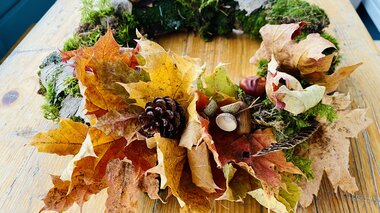Adaptive skiing in Zell am See-Kaprun
"I wanted everyone to have the opportunity to enjoy a ski holiday when and how they want," says Caroline Ooms. In 2017, the native Dutchwoman started UP Adaptive Sports, the first adaptive ski school in the Zell am See-Kaprun region, which specialises entirely in the needs of people with disabilities.
"Whatever your age and whether beginner or expert, in a wheelchair or standing, blind or with visual impairment, we try to make skiing or snowboarding possible for everyone," says Caroline of UP (Unlimited Possibilities) Adaptive Sports in Zell am See-Kaprun. Her courses are always private and individually tailored to the requirements and needs of her guests. Currently, Caroline accompanies her guests to the pistes herself whenever possible and also employs two other trained ski instructors who also work at her partner ski school Oberschneider. Together they make sure that their guests feel safe and in good hands.
Before UP Adaptive Sports, the 38-year-old Dutchwoman worked for a long time at the Dutch Ski Federation and was responsible for the development and expansion of adaptive winter sports in both amateur and professional sports. She organised courses and trainings as well as European Cup and World Cup races. In doing so, she has always noticed that the possibilities for individual skiing holidays for people with disabilities are very limited. With UP Adaptive Sports she wanted to change that - and chose the Zell am See-Kaprun region for it.
Versatility and good infrastructure as a plus
After her time with the Dutch Ski Association, Caroline spent a winter season in Zell am See-Kaprun. Trained by her experience, she saw the possibilities the region offers for adaptive skiing even then.
"Because of the versatile and diverse terrain, there are good conditions in Zell am See-Kaprun for adaptive skiing with monoskis or dual skis (for sitting skiers), for guided skiing with a guide (for example for blind or visually impaired people) or with ski crutches (for standing skiers)."
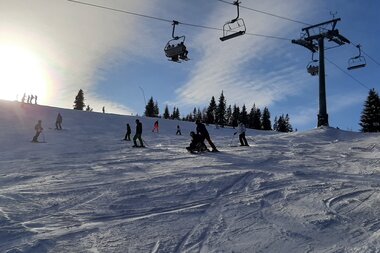
Caroline‘s tips for the piste
Her recommendation for beginners is the Lechnerberg with its easy, flat piste. The T-bar lift that leads uphill here is a good access point and the staff there now have plenty of experience with seated skiers using dual skis or monoskis. When Caroline started her ski school in 2017, the staff were often not yet sure of how to deal with her guests. "As a beginner, even a skier without a disability falls at the T-bar lift. So why should it be any different with adaptive skiing?", Caroline reassures.

In addition to the Lechnerberg, Caroline also appreciates the ski area on the Maiskogel. This area is ideal for families in particular. Here there is a gondola lift as well as a chairlift and T-bar lift - so lots of opportunities to try out taking the lift. The UP Adaptive Sports team is also happy to take beginners and experienced skiers on the wide pistes in the panorama and family ski resort Schmittenhöhe. "I want to show the guests as much of the region as possible," Caroline explains.
The snow-reliable Kitzsteinhorn glacier ski area, with its extra-long ski season, is visited mainly by guests who already have a bit of experience in adaptive skiing. In addition to the wide glacier pistes, there are also many red and black pistes here, as well as fun parks that can be checked out by advanced monoskiers and dual skiers.
Gondola lifts and chairlifts can also be used with monoskis and dual skis. However, unlike many other ski guests, Caroline prefers for her clients the "old" chairlifts without child safety locks and bars that close automatically between the legs. They are impractical for monoskiers and dual skiers.
With the gondolas, it's the other way round: here, the large, barrier-free gondolas are more suitable. If the gondolas are not barrier-free, the UP Adaptive Sports team helps out with a trolley that they developed themselves, making it possible to get on and off.
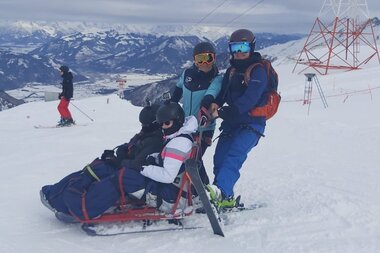
Equipment hire: from dual skis to crutch skis
UP Adaptive Sports not only offers courses, but also equipment hire. "Only a few own dual ski or monoski themselves, as they are very expensive to buy." The sports equipment costs up to 6,000 Euros. However, the hire equipment can only be booked as part of an accompanying course: "If you don't know how to ski with a monoski and dual ski, it can be dangerous," says Caroline. With adaptive skiing, athletes are usually dependent on helping hands - for example, when getting on and off the skis.
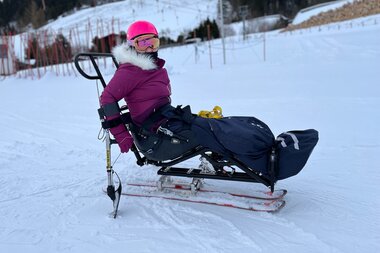
But the monoskis or dual skis are not the only sports equipment used for adaptive skiing. Visually impaired or blind people ski with classic ski equipment, but are guided by a guide and instructed via radio. At Caroline’s, the ski instructor and guest also wear the same ski suits or vests so that the other skiers on the piste are aware and can act with due consideration. People with an amputated leg, but who basically have good balance, stability and enough muscle strength, can also ski standing up with crutch skis. "The requirements are always individual," says Caroline. That's why preparation is also crucial for a successful adaptive skiing holiday.
For a stress-free ski holiday: plenty of time for consultation
"I always clarify all wishes and questions in advance in a conversation so that we can also offer the right thing," says Caroline. When guests arrive in Zell am See-Kaprun, Caroline or her guides pay them a welcome visit and introduce themselves personally. They explain the equipment, tell them about the region and the downhill runs. "Many of my guests need so much more energy for the day because of their disability. I don't want them to use up even more of their energy because of their nervousness, lack of clarity or worries about how the course will go. If you feel unsafe, you can't really enjoy skiing and nature.“
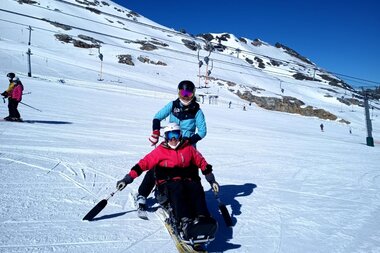
Some of her guests also imagine skiing to be easy: "But like any novice skier, my clients need to practice a lot." How quickly adaptive skiing can be learned and how much is possible also depends on physical fitness in general. "In the end, it's sport. And even if you have people around you on the pistes to support you, you have to do your own part," says Caroline.
Seeing your own strength
Very often, skiing is a very emotional event for her guests: "There are always tears. If the ski course is a positive experience, it gives people a lot of confidence in their own strength," says Caroline. And she says that many of her guests become regulars. "It's also a great compliment for the region."
Want to see the adaptive skiing course for yourself? This way:
